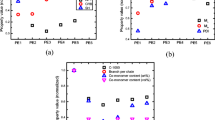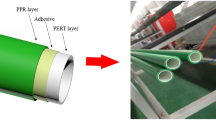Abstract
In this work, step-cycle tensile behavior of two bimodal polyethylene (PE) materials, a PE100 grade pipe material, XS10, and a PE100-RC (Resistant Crack) grade pipe material, XSC50, was comparatively investigated. By decomposing the strain into a recoverable part and an unrecoverable part, it was found that the deformation recovery capability of XSC50 during stretching was larger than that of XS10. Structural evolution characterized by in situ synchrotron small angle X-ray scattering indicated that the fragmentation of initial crystals in XSC50 occurred at lower strain than in XS10. Considering that XSC50 had relatively small lamellar thickness and similar crystallinity to XS10, we speculated that the larger deformation recovery capability of XSC50 during stretching probably derived from stronger entangled amorphous region caused by larger density of tie molecules and entanglements, which were usually regarded to have a significant influence on the slow crack growth (SCG) resistance of PE materials. As expected, the experimental result of strain hardening modulus test suggested that the deformation recovery capability during stretching was positively correlated with the SCG resistance for XS10 and XSC50 used in this work. The step-cycle tensile test had the potential to be developed into a supplement for comparison of SCG resistance of PE materials.
Similar content being viewed by others
References
Institute, P. P., in Handbook of polyethylene pipe, Plastics Pipe Institute: Irving, Texas, 2007.
Peacock, A., in Handbook of polyethylene: structures, properties, and applications, CRC Press, 2000.
Wu, T.; Yu, L.; Cao, Y.; Yang, F.; Xiang, M. Effect of molecular weight distribution on rheological, crystallization and mechanical properties of polyethylene-100 pipe resins. J. Polym. Res.2013, 20, 271.
ISO 12162: 2009, Thermoplastics materials for pipes and fittings for pressure applications—classification, designation and design coefficient.
ISO 9080: 2012, Plastics piping and ducting systems—Determination of the long-term hydrostatic strength of thermoplastics materials in pipe form by extrapolation.
Arbeiter, F.; Austria, L.; Pinter, G. Characterization of slow crack growth resistance of polyethylene pipe grades with cyclic cracked round bar (CRB) test in correlation to strain hardening (SH) test. In ANTEC, Society of Plastics Engineers Incorporated (SPE): Anaheim, 2017, Vol. 37.
Pinter, G.; Haager, M.; Balika, W.; Lang, R. W. Cyclic crack growth tests with CRB specimens for the evaluation of the long-term performance of PE pipe grades. Polym. Test.2007, 26, 180–188.
Kratochvilla, T. R.; Frank, A.; Pinter, G. Determination of slow crack growth behaviour of polyethylene pressure pipes with cracked round bar test. Polym. Test.2014, 40, 299–303.
Shen, H.; Xie, B.; Yang, W.; Yang, M. Non-isothermal crystallization of polyethylene blends with bimodal molecular weight distribution. Polym. Test.2013, 32, 1385–1391.
Alt, F. P.; Böhm, L. L.; Enderle, H. F.; Berthold, J. Bimodal polyethylene-interplay of catalyst and process. Macromol. Symp.2001, 163, 135–144.
Strobl, G. R., in The physics of polymers. Springer-Verlag Berlin Heidelberg, 2007.
Fan, Y.; Xue, Y.; Nie, W.; Ji, X.; Bo, S. Characterization of the microstructure of bimodal HDPE resin. Polym. J.2009, 41, 622–628.
Pan, Y.; Gao, X.; Wang, Z.; Lei, J.; Li, Z.; Shen, K. Effect of different morphologies on slow crack growth of high-density polyethylene. RSC Adv.2015, 5, 28191–28202.
DesLauriers, P. J.; Rohlfing, D. C. Estimating slow crack growth performance of polyethylene resins from primary structures such as molecular weight and short chain branching. Macromol. Symp.2009, 282, 136–149.
Lustiger, A.; Corneliussen, R. The role of crazes in the crack growth of polyethylene. J. Mater. Sci.1987, 22, 2470–2476.
Narisawa, I.; Yee, A., in Crazing and fracture of polymers. Wiley Online Library, 2006.
Bhattacharya, S. K.; Brown, N. Micromechanisms of crack initiation in thin films and thick sections of polyethylene. J. Mater. Sci.1984, 19, 2519–2532.
Fawaz, J.; Deveci, S.; Mittal, V. Molecular and morphological studies to understand slow crack growth (SCG) of polyethylene. Colloid Polym. Sci.2016, 294, 1269–1280.
Hiss, R.; Hobeika, S.; Lynn, C.; Strobl, G. Network stretching, slip processes, and fragmentation of crystallites during uniaxial drawing of polyethylene and related copolymers a comparative study. Macromolecules1999, 32, 4390–4403.
Brömstrup, H. in PE100 pipe systems. Vulkan-Verlag GmbH, 2004.
ÖVGW QS-G 392/2: 2013, Polyethylene piping systems PE80, PE100 and PE100-RC for the supply of gaseous fuels, Part 2: pipes.
ÖVGW/GRIS PW 405/1: 2012, Polyethylene PE100-RC pipe systems for alternative installation techniques for the supply of drinking water.
O’Connell, P. A.; Bonner, M. J.; Duckett, R. A.; Ward, I. M. The relationship between slow crack propagation and tensile creep behaviour in polyethylene. Polymer1995, 36, 2355–2362.
Cawood, M.; Channell, A.; Capaccio, G. Crack initiation and fibre creep in polyethylene. Polymer1993, 34, 423–425.
Rose, L. J.; Channell, A. D.; Frye, C. J.; Capaccio, G. Slow crack growth in polyethylene: a novel predictive model based on the creep of craze fibrils. J. Appl. Polym. Sci.1994, 54, 2119–2124.
Kurelec, L.; Teeuwen, M.; Schoffeleers, H.; Deblieck, R. Srrain hardening modulus as a measure of environmental stress crack resistance of high density polyethylene. Polymer2005, 46, 6369–6379.
Capaccio, G. Structural changes in the preparation of ultra-high modulus polyethylene. Pure Appl. Chem.1983, 55, 869–872.
Brown, N.; Lu, X. A fundamental theory for slow crack growth in polyethylene. Polymer1995, 36, 543–548.
Lu, X.; Mcghie, A.; Brown, N. The dependence of slow crack growth in a polyethylene copolymer on test temperature and morphology. J. Polym. Sci., Part B: Polym. Phys.1922, 30, 1207–1214.
Brown, N.; Ward, I. M. The influence of morphology and molecular weight on ductile-brittle transitions in linear polyethylene. J. Mater. Sci.1983, 18, 1405–1420.
Deveci, S.; Fang, D. Correlation of molecular parameters, strain hardening modulus and cyclic fatigue test performances of polyethylene materials for pressure pipe applications. Polym. Test.2017, 62, 246–253.
He, X.; Zha, X.; Zhu, X.; Qi, X.; Liu, B. Effect of short chain branches distribution on fracture behavior of polyethylene pipe resins. Polym. Test.2018, 68, 219–228.
ISO 18488: 2015, Polyethylene (PE) materials for piping systems—determination of strain hardening modulus in relation to slow crack growth—test method.
Cheng, J. J.; Polak, M. A.; Penlidis, A. Polymer network mobility and environmental stress cracking resistance of high density polyethylene. Polym. Plast. Technol.2009, 48, 1252–1261.
Hong, K.; Rastogi, A.; Strobl, G. A model treating tensile deformation of semicrystalline polymers: quasi-static stressstrain relationship and viscous stress determined for a sample of polyethylene. Macromolecules2004, 37, 10165–10173.
Men, Y.; Rieger, J.; Strobl, G. Role of the entangled amorphous network in tensile deformation of semicrystalline polymers. Phys. Rev. Lett.2003, 91, 095502.
Jiang, Z.; Tang, Y.; Rieger, J.; Enderle, H. F.; Lilge, D.; Roth, S. V.; Gehrke, R.; Heckmann, W.; Men, Y. Two lamellar to fibrillar transitions in the tensile deformation of high-density polyethylene. Macromolecules2010, 43, 4727–4732.
Sun, Y.; Fu, L.; Wu, Z.; Men, Y. Structural evolution of ethylene-octene copolymers upon stretching and unloading. Macromolecules2013, 46, 971–976.
Kida, T.; Oku, T.; Hiejima, Y.; Nitta, K. H. Deformation mechanism of high-density polyethylene probed by in situ Raman spectroscopy. Polymer2015, 58, 88–95.
Seger, M. R.; Maciel, G. E. Quantitative 13C NMR analysis of sequence distributions in poly(ethylene-co-1-hexene). Anal. Chem.2004, 76, 5734–5747.
Nitta, K. H.; Tanaka, A. Dynamic mechanical properties of metallocene catalyzed linear polyethylenes. Polymer2001, 42, 1219–1226.
Nakayasu, H.; Markovitz, H.; Plazek, D. The frequency and temperature dependence of the dynamic mechanical properties of a high density polyethylene. T. Soc. Rheol.1961, 5, 261–283.
Kajiyama, T.; Okada, T.; Sakoda, A.; Takayanagi, M. Analysis of the a-relaxation process of bulk crystallized polyethylene based on that of single crystal mat. J. Macromol. Sci. B1973, 7, 583–608.
Müller, A. J.; Arnal, M. L. Thermal fractionation of polymers. Prog. Polym. Sci.2005, 30, 559–603.
Jiang, Z.; Tang, Y.; Men, Y.; Enderle, H. F.; Lilge, D.; Roth, S. V.; Gehrke, R.; Rieger, J. Structural evolution of tensile-deformed high-density polyethylene during annealing: scanning synchrotron small-angle X-ray scattering study. Macromolecules2007, 40, 7263–7269.
Jiang, Z.; Tang, Y.; Rieger, J.; Enderle, H. F.; Lilge, D.; Roth, S. V.; Gehrke, R.; Wu, Z.; Li, Z.; Men, Y. Structural evolution of tensile deformed high-density polyethylene at elevated temperatures: Scanning synchrotron small- and wide-angle X-ray scattering studies. Polymer2009, 50, 4101–4111.
Beech, S.; Clutton, E. Interpretation of results of full notch creep test and comparison with notched pipe test. Plast. Rubber Compos.2005, 34, 294–300.
ISO 13479: 2009, Polyolefin pipes for the conveyance of fluids—determination of resistance to crack propagation—test method for slow crack growth on notched pipes.
ISO 16241: 2005, Notch tensile test to measure the resistance to slow crack growth of polyethylene materials for pipe and fitting products (PENT).
ISO 16770: 2004, Plastics—determination of environmental stress cracking (ESC) of polyethylene—full-notch creep test (FNCT).
Acknowledgments
We gratefully acknowledge the financial support from the National Natural Science Foundation of China (Nos. 51773040 and 21574029) and PetroChina Company Limited, China. We also greatly thank for the beam time provided by Shanghai Synchrotron Radiation Facility.
Author information
Authors and Affiliations
Corresponding author
Electronic Supplementary Information
10118_2020_2364_MOESM1_ESM.pdf
Comparative Investigation on Step-cycle Tensile Behaviors of Two Bimodal Pipe-grade Polyethylene with Different Slow Crack Growth Resistance
Rights and permissions
About this article
Cite this article
Huang, YQ., Zhang, QL., Lu, XY. et al. Comparative Investigation on Step-cycle Tensile Behaviors of Two Bimodal Pipe-grade Polyethylene with Different Slow Crack Growth Resistance. Chin J Polym Sci 38, 611–619 (2020). https://doi.org/10.1007/s10118-020-2364-3
Received:
Accepted:
Published:
Issue Date:
DOI: https://doi.org/10.1007/s10118-020-2364-3




